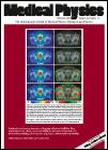版权所有:内蒙古大学图书馆 技术提供:维普资讯• 智图
内蒙古自治区呼和浩特市赛罕区大学西街235号 邮编: 010021

作者机构:CRCHUM Lab Biorheol & Med Ultrason Montreal PQ H2L 2W5 Canada Univ Montreal Inst Biomed Engn Montreal PQ H3T 1J4 Canada Univ Montreal Dept Radiol Radiooncol & Nucl Med Montreal PQ H3T 1J4 Canada CHUM Dept Radiol Montreal PQ H2L 4M1 Canada
出 版 物:《MEDICAL PHYSICS》 (医疗物理学)
年 卷 期:2010年第37卷第7期
页 面:3868-3879页
核心收录:
学科分类:1001[医学-基础医学(可授医学、理学学位)] 1009[医学-特种医学] 10[医学]
基 金:Canadian Institutes of Health Research (CIHR) [MOP 53244] Fonds de la Recherche en Sante du Quebec (FRSQ) Fonds de la Recherche sur la Nature et les Technologies du Quebec TD Canada Trust Institute of Biomedical Engineering at Universite de Montreal Quebec Black Medical Association Faculty of Graduate and Postgraduate Studies at Universite de Montreal
主 题:3D-ultrasound imaging system cardiovascular imaging robotics ultrasound probe calibration 3D-ultrasound reconstruction precision and accuracy evaluations calibration phantom lower limb arterial disease computer-assisted image processing
摘 要:Purpose: The degree of stenosis is the most important criterion to assess peripheral arterial disease manifested by atherosclerosis mainly in lower limb arteries. Ultrasound (U.S.) imaging offers low-cost, safe, and convenient options to evaluate this disease, but most U.S. freehand approaches cannot optimally locate stenoses and map lower limb arterial geometries. A 3D-U.S. imaging robotic system that can control and standardize image acquisition by scanning typically encountered diseased arterial lower limb segments is presented and validated with phantoms. Methods: A Z-phantom calibration procedure was used to characterize spatial transformation of the U.S. probe image plane for different clinical image acquisition settings. Moreover, the accuracy of the calibration transform to reconstruct a lower-limb-mimicking vessel geometry was evaluated with a vascular phantom. Results: A 3D calibration precision of 0.47 +/- 0.27 mm was achieved. Reconstruction errors were less than 1.74 +/- 0.08 mm in all 3D vessel representations and the cross-sectional areas of each image section were close to those of gold standard phantom measures. The best reconstruction accuracy (smallest error) was 0.40 +/- 0.03 mm. Conclusion: Altogether, these results demonstrate the potential of the robotic scanner to adequately represent lower limb vessels for the clinical evaluation of stenoses. (C) 2010 American Association of Physicists in Medicine. [DOI: 10.1118/1.3447721]